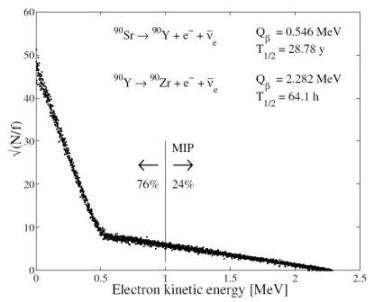
Minimum ionizing particles (MIPS) are charged particles, which embody the minimum ionizing losses in substances. This situation occurs when the kinetic energy of particles is at least twice larger than their rest mass. For example, electrons (or protons) can be considered as minimum ionizing particles when their kinetic energy is greater than 1 MeV (or GeV 2). Since the ionization losses of these particles are only weakly dependent on their momentum, it is generally accepted that a minimum ionizing particles produce an even distribution of free charge carriers along their paths.
Minimum ionizing particles, such as protons or pions, are prepared on the accelerator of elementary particles. In laboratory conditions it is possible to use some beta emitters such as 90Sr 90 Y (90Y is a subsidiary product 90Sr). The maximum energy of electrons emitted is 2.28 MeV. The relative number of electrons, which can be regarded as minimum ionizing particles, is at 24% (i.e., on average, every fourth electron has energy greater than 1 MeV). To determine the electrons, which have the requisite kinetic energy; it is necessary to use additional detection equipment. Such devices may be absorption medium in the form of thin AL foil, which can penetrated only by electrons of appropriate energy, followed by rapid detection (e.g. plastic scintillators coupled to a fast photomultiplier tube).
Accelerators of elementary particles providing protons and pions at high energy are the most appropriate source of minimum ionizing particles for testing radiation detectors developed for the new accelerators. Their disadvantage is the limited experimental time, in which it is possible to carry out the tests. In contrast, beta emitters can be used in laboratories at any time and for any long period of time. Their limiting factor is associated with large fluctuations in the directions of beta particles passing through matter.
(0)






 Experimental physics
with polarized protons, neutrons and deuterons
Experimental physics
with polarized protons, neutrons and deuterons Progressive detection methods in atomic and particle physics education at middle and high school level
Progressive detection methods in atomic and particle physics education at middle and high school level NSS MIC IEEE Conference
NSS MIC IEEE Conference SEPnet, CERN@school Conference
SEPnet, CERN@school Conference Lovci záhad - natáčení ČT ve spolupráci s ÚTEF
Lovci záhad - natáčení ČT ve spolupráci s ÚTEF Advanced detection methods in atomic and subatomic physics education.
Advanced detection methods in atomic and subatomic physics education. Listening to the universe by detection cosmic rays - visit of French and Czech students
Listening to the universe by detection cosmic rays - visit of French and Czech students NSS MIC IEEE Conference
NSS MIC IEEE Conference 15thIWORID
15thIWORID NSS MIC IEEE Conference
NSS MIC IEEE Conference